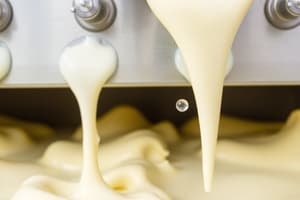Podcast
Questions and Answers
What is the main purpose of fermentation in food processing?
What is the main purpose of fermentation in food processing?
- To generate energy through the electron transport system
- To convert carbohydrates to alcohol or organic acids using microorganisms (correct)
- To produce ATP by degrading organic nutrients aerobically
- To release oxygen as a byproduct of the metabolic process
Which type of fermentation occurs in the presence of oxygen?
Which type of fermentation occurs in the presence of oxygen?
- Aerobic fermentation (correct)
- Anaerobic respiration
- Ethanol fermentation
- Alcoholic fermentation
What is the primary means of producing ATP by the degradation of organic nutrients anaerobically?
What is the primary means of producing ATP by the degradation of organic nutrients anaerobically?
- Alcoholic fermentation
- Anaerobic respiration
- Zymology
- Fermentation (correct)
Which microorganisms typically perform Ethanol/Alcoholic fermentation?
Which microorganisms typically perform Ethanol/Alcoholic fermentation?
What differentiates anaerobic fermentation from anaerobic respiration?
What differentiates anaerobic fermentation from anaerobic respiration?
What does zymology refer to in the context of fermentation?
What does zymology refer to in the context of fermentation?
What is the end product of alcoholic fermentation?
What is the end product of alcoholic fermentation?
How many molecules of ethanol are produced from the fermentation of one molecule of glucose?
How many molecules of ethanol are produced from the fermentation of one molecule of glucose?
Which type of fermentation involves the conversion of pyruvate to lactate without releasing gas?
Which type of fermentation involves the conversion of pyruvate to lactate without releasing gas?
Which organisms are involved in transforming sugars to lactic acid in lactic acid fermentations?
Which organisms are involved in transforming sugars to lactic acid in lactic acid fermentations?
What is the purpose of the phosphoketolase pathway in heterolactic fermentation?
What is the purpose of the phosphoketolase pathway in heterolactic fermentation?
What distinguishes homolactic fermentation from heterolactic fermentation?
What distinguishes homolactic fermentation from heterolactic fermentation?
What is the role of lactic acid-producing bacteria in food fermentation?
What is the role of lactic acid-producing bacteria in food fermentation?
Which of the following is an example of a lactic acid-fermented food mentioned in the text?
Which of the following is an example of a lactic acid-fermented food mentioned in the text?
What is the key role of solid state fermentation in food production?
What is the key role of solid state fermentation in food production?
In solid state fermentation, what are biomolecules that are utilized in food manufacture?
In solid state fermentation, what are biomolecules that are utilized in food manufacture?
Which microorganisms are commonly encountered in fermentation processes according to the text?
Which microorganisms are commonly encountered in fermentation processes according to the text?
What happens when lactic acid-producing bacteria 'stray' from their intended location according to the text?
What happens when lactic acid-producing bacteria 'stray' from their intended location according to the text?
Flashcards are hidden until you start studying




